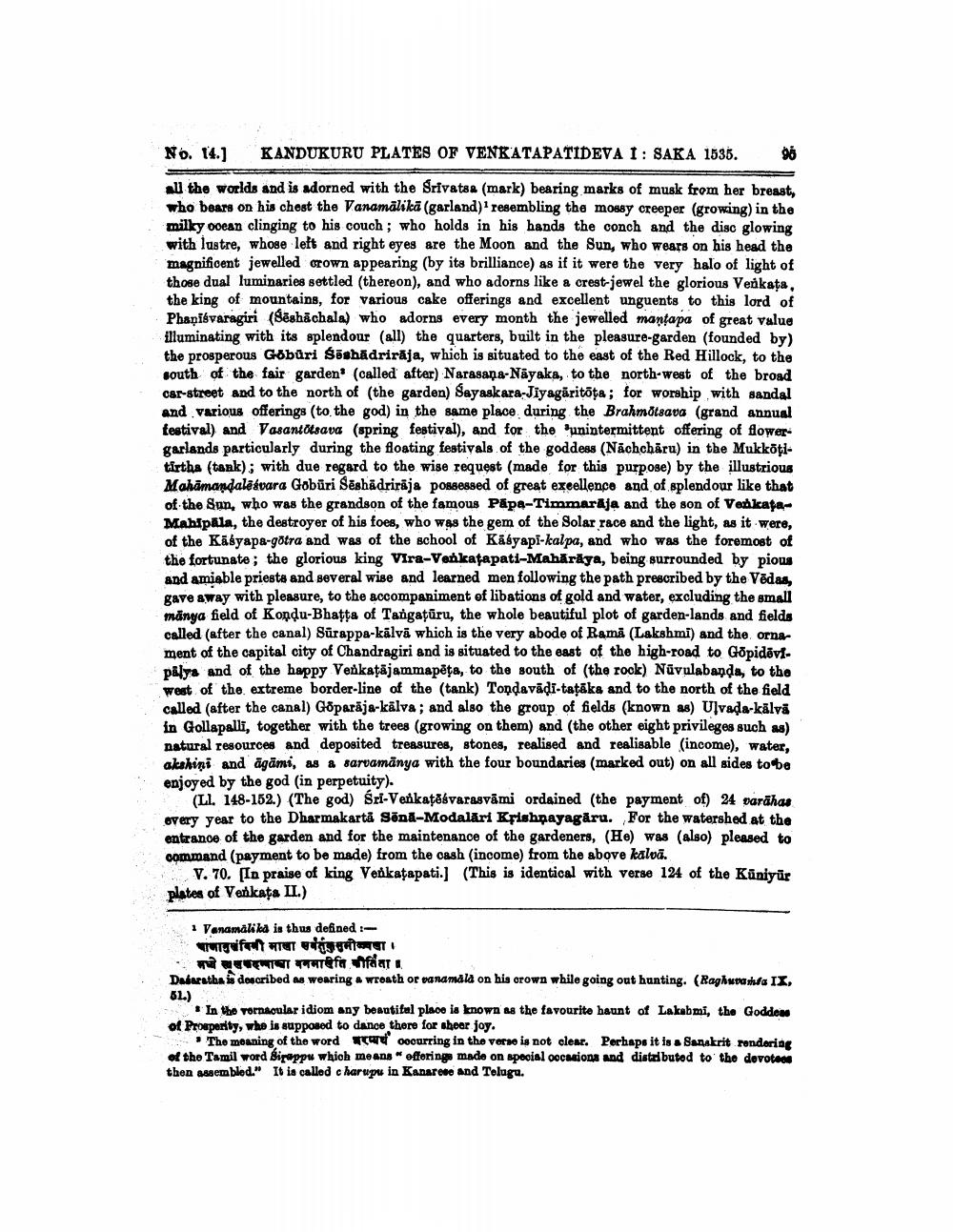________________
No. 14.]
KANDUKURU PLATES OF VENKATAPATIDEVA I: SAKA 1535. 98
all the worlds and is adorned with the Srivatsa (mark) bearing marks of musk from her breast, who bears on his chest the Vanamalikā (garland)1 resembling the mossy creeper (growing) in the milky ocean clinging to his couch; who holds in his hands the conch and the disc glowing with lustre, whose left and right eyes are the Moon and the Sun, who wears on his head the magnificent jewelled crown appearing (by its brilliance) as if it were the very halo of light of those dual luminaries settled (thereon), and who adorns like a crest-jewel the glorious Venkata, the king of mountains, for various cake offerings and excellent unguents to this lord of Phanisvaragiri (Seshachala) who adorns every month the jewelled mantapa of great value illuminating with its splendour (all) the quarters, built in the pleasure-garden (founded by) the prosperous Gōbūri Śēshādrirāja, which is situated to the east of the Red Hillock, to the south of the fair garden (called after) Narasana-Nayaka, to the north-west of the broad car-street and to the north of (the garden) Sayaakara-Jiyagaritöța; for worship with sandal and various offerings (to the god) in the same place during the Brahmotsava (grand annual festival) and Vasantotsava (spring festival), and for the unintermittent offering of flower. garlands particularly during the floating festivals of the goddess (Nachcharu) in the Mukkōţitirtha (tank); with due regard to the wise request (made for this purpose) by the illustrious Mahamandalesvara Goburi Seshadriraja possessed of great excellence and of splendour like that of the Sun, who was the grandson of the famous Papa-Timmarāja and the son of VenkataMahipala, the destroyer of his foes, who was the gem of the Solar race and the light, as it were, of the Kasyapa-götra and was of the school of Kasyapi-kalpa, and who was the foremost of the fortunate; the glorious king Vira-Venkatapati-Mahārāya, being surrounded by pious and amiable priests and several wise and learned men following the path prescribed by the Vedas, gave away with pleasure, to the accompaniment of libations of gold and water, excluding the small manya field of Kondu-Bhaṭṭa of Tangațūru, the whole beautiful plot of garden-lands and fields called (after the canal) Surappa-kälva which is the very abode of Rama (Lakshmi) and the ornament of the capital city of Chandragiri and is situated to the east of the high-road to Gōpidevipalya and of the happy Venkaṭājammapeta, to the south of (the rock) Nüvulabanda, to the west of the extreme border-line of the (tank) Tondavādi-taṭāka and to the north of the field called (after the canal) Gōparāja-kälva; and also the group of fields (known as) Ulvada-kälvā in Gollapalli, together with the trees (growing on them) and (the other eight privileges such as) natural resources and deposited treasures, stones, realised and realisable (income), water, akshini and āgāmi, as a sarvamanya with the four boundaries (marked out) on all sides to be enjoyed by the god (in perpetuity).
(Ll. 148-152) (The god) Sri-Venkatesvarasvami ordained (the payment of) 24 varahas every year to the Dharmakarta Sēnā-Modalāri Krishnayagāru. For the watershed at the entrance of the garden and for the maintenance of the gardeners, (He) was (also) pleased to command (payment to be made) from the cash (income) from the above kalvā.
V. 70. [In praise of king Venkatapati.] (This is identical with verse 124 of the Kuniyur plates of Venkata II.)
1 Vanamalika is thus defined :
winguifat are w
मध्ये कन्याया मनमादेति कीर्तिता ॥
Dasaratha is described as wearing a wreath or vanamala on his crown while going out hunting. (Raghuvama IX, 51.)
In the vernacular idiom any beautifal place is known as the favourite haunt of Lakabmi, the Goddess of Prosperity, who is supposed to dance there for sheer joy.
The meaning of the word w
occurring in the verse is not clear. Perhaps it is a Sanskrit rendering of the Tamil word Sirappu which means "efferings made on special occasions and distributed to the devotees then assembled." It is called charupu in Kanarese and Telugu.




